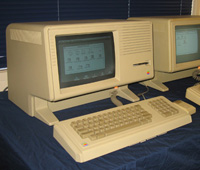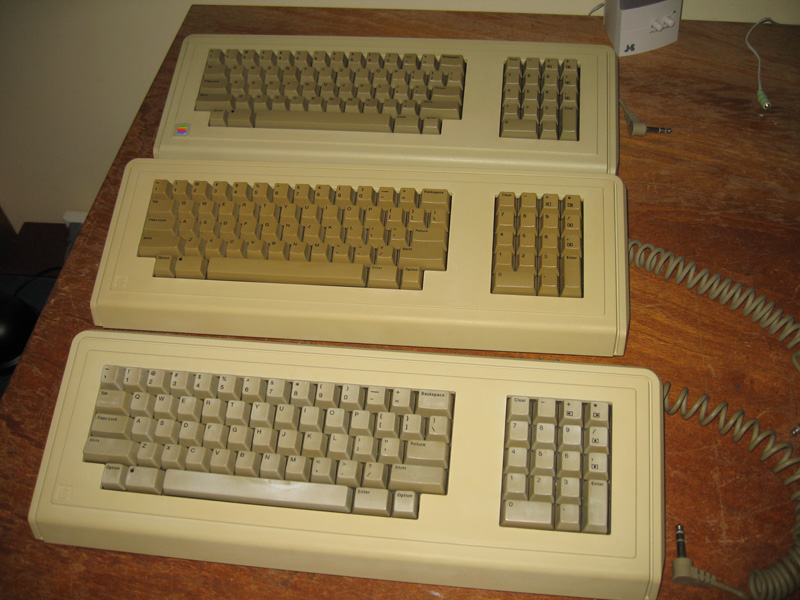Keys damaged on an Apple Lisa. Poor retr0bright technique possibly at fault
 Introduction
Introduction
I've been enjoying myself lately slowly restoring a couple of Lisa 2s. The task is all but complete and now I have two Lisas up and running. There exists a third Lisa which I've decided will remain a parts-only machine.
One of the machines was pretty much its original colour. However two were quite yellowed. The parts machine I decided not to recondition. However the other yellowed one I processed using the classic Retr0bright recipe. The case came up really well. It's the machine on the right in the photo opposite.
Even though one belonged to the parts machine, I decided to de-yellow BOTH of the yellowed keyboard cases. For these I tried something different. For the soak I used a high concentration of laundry activator only instead of the usual recipe (i.e. dilute hydrogen peroxide with a pinch of activator). This was very successful, and much cheaper than paying for straight hydrogen peroxide.
The only remaining task now was to process the keys themselves. These were not so much yellowed but rather a khaki colour. Acceptable enough, but I wanted them back to their original beige, at least for the keyboard I intended to use with the working de-yellowed machine.
The process
I dissolved three large heaped tablespoons of "Napisan" (with 25% sodium percarbonate) in about 4 litres of warm water in a shallow tray. This is not my usual activator, but it was the one in the laundry on that day. Normally I would use Oxy-Magic, which has 35% of the active ingredient. I then added the keys to the tray. They sat underwater in a single layer, weighed down with bluetak stuffed inside each one of them. I placed the whole batch out in full sunlight.
I checked the keys after three hours. To my surprise there didn't seem to be much oxidation going on. By this I mean there weren't many obvious bubbles coming off the keys which is the normal sign of deyellowing taking place. I wondered if the "Napisan" concentration was too weak so I added another tablespoon of activator. I simply sprinkled this on the surface of the water then gently tried to stir it in without disturbing the keys. On reflection this was probably my biggest mistake. The water was now cold and I couldn't agitate it. It is likely that much of the activator didn't dissolve but instead just settled on the keys.
I let the mixture sit for another three hours, then washed and dried the keys.
Result
Not good. The keys deyellowed but nearly all showed signs of "bloom", a spotty/streaky irreversible bleaching of the plastic.
The photo below shows this well. The keyboard at the top is normal (not yellowed). The keyboard in the middle has a treated case, but the keys were not treated. Note the darker colour. The keyboard at the bottom contains the keys which were treated as described above.

Figure 1. Bottom keyboard showing damage to the key plastic
Reflections
Blooming is a known hazard when using the Retr0bright technique. It tends to occur on coloured cases or keys, when the process has been allowed to go on for too long or the concentration of hydrogen peroxide + UV is too strong. Why did it happen here? In thinking about it, I came up with the following possibilities. The strongest suspects are at the top.
- When I added the second batch of laundry activator some undissolved power sat directly on top of the keys, causing an extremely high level of H2O2 at the point of contact. (I think this is the main reason)
- Other additives in the laundry activator exacerbated the effect (this could also be a factor)
- The concentration of laundry activator lead to very damaging levels of hydrogen peroxide.
- Apple Lisa keys are sensitive to this technique
I suspect the damage would have been less (if at all) had I used the conventional Retr0bright recipe. However I don't know that for sure. The take-home message is that care has to be taken in deyellowing any plastics whose default colour is not white or very pale cream.
It's not a disaster for me, as my third Lisa is just a spare anyway and I'm prepared to tolerate the non-processed darker-than-normal keys on the second Lisa. For the damaged keyboard though, I may not be able to sell it for as much as I might have before the key soak.
Anyway, it's all a learning curve. Hopefully this write-up will alert others to the possible problems and pitfalls associated with this technique.
Tez
11th April, 2011
| Tweet |